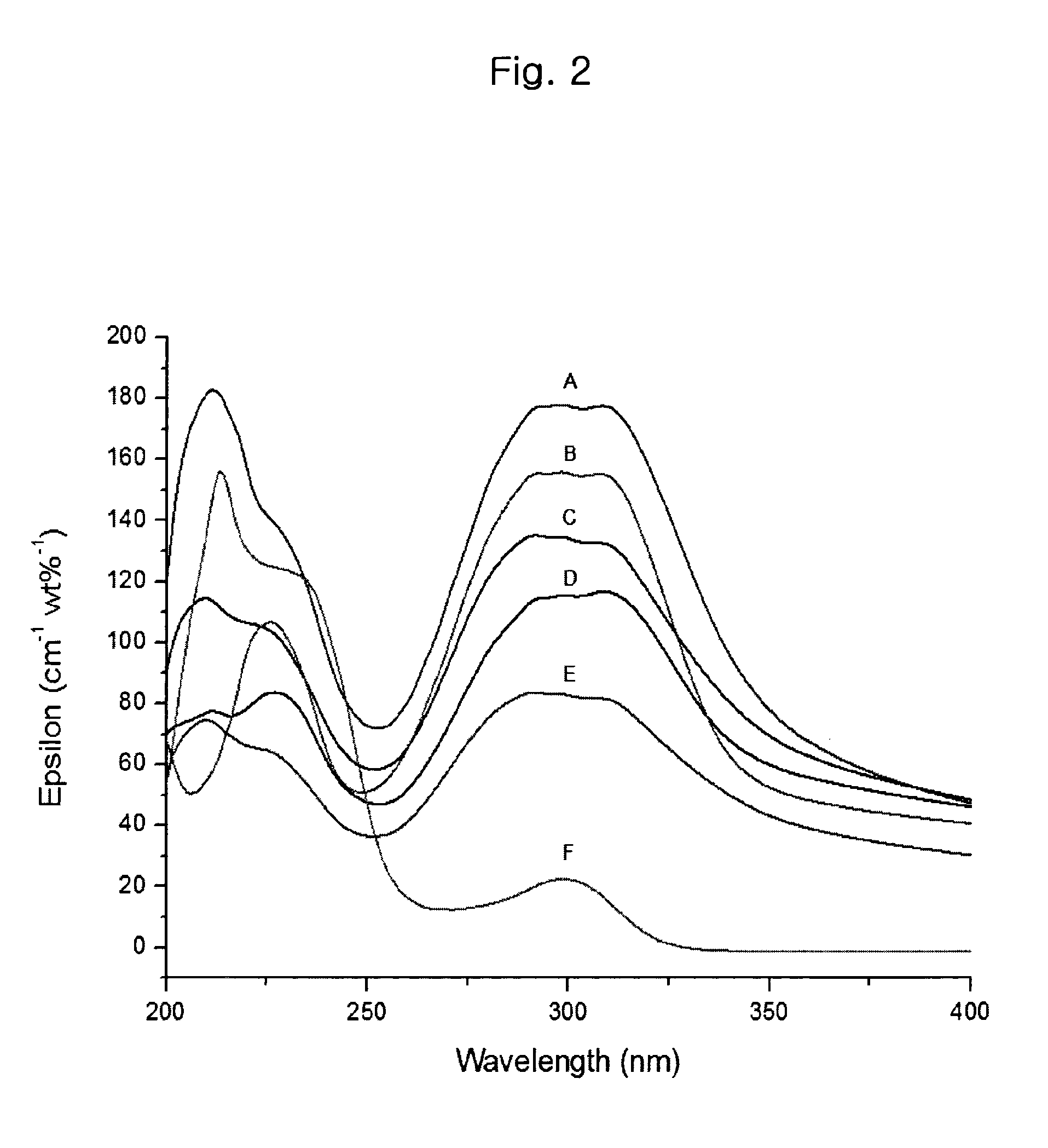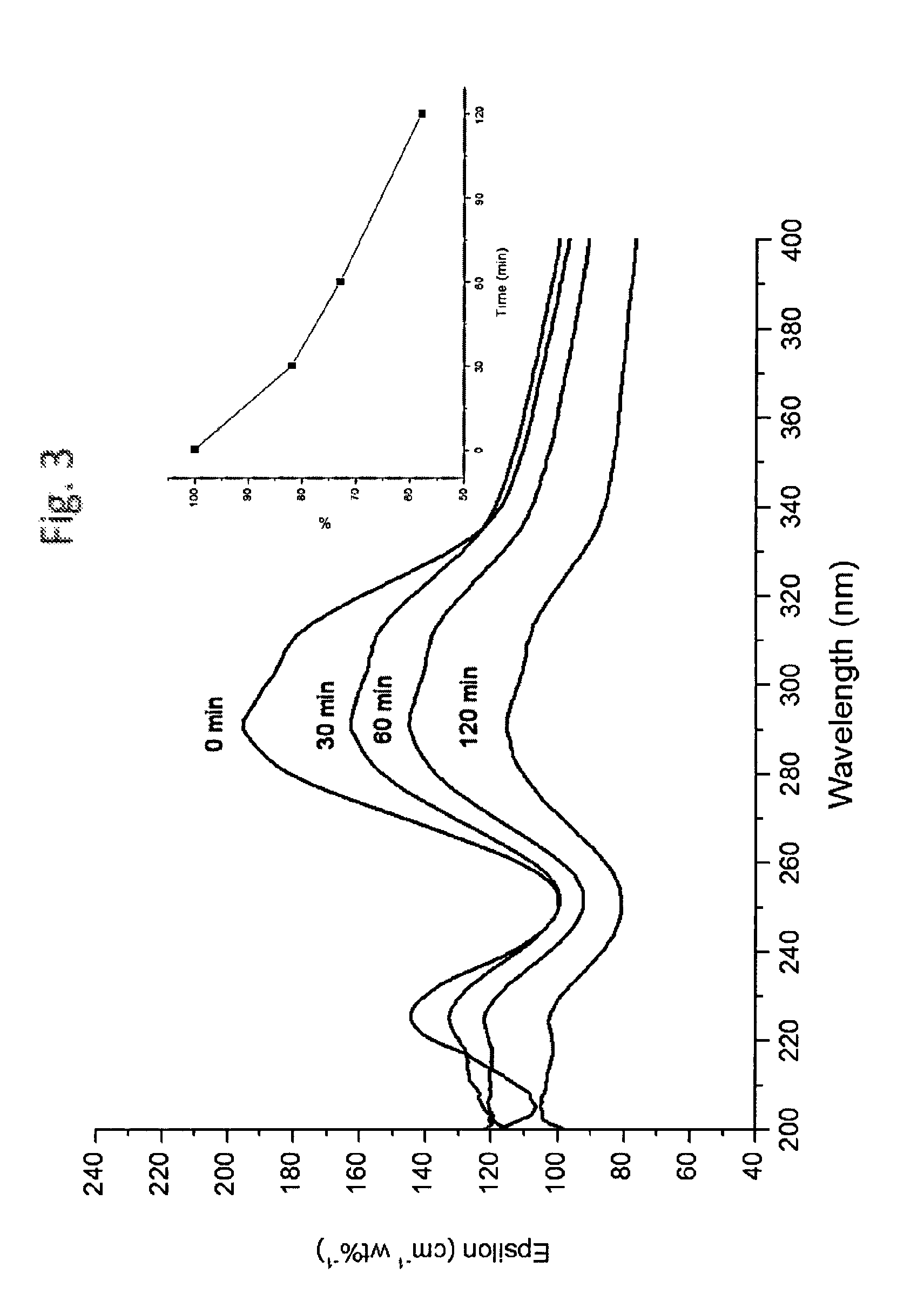Ultraviolet absorbing poly (organic oxidized silicon) particles having improved ultraviolet stability, and method for preparing same
a technology of organic oxidized silicon and ultraviolet stability, which is applied in the field of ultraviolet absorption poly (organic oxidized silicon) particles, can solve the problems of more than 100 nm in size, inappropriate use may be harmful to the human body, burns or skin cancer, etc., and achieves improved uv stability, improved uv absorption ability and uv stability. , the effect of improving uv stability
- Summary
- Abstract
- Description
- Claims
- Application Information
AI Technical Summary
Benefits of technology
Problems solved by technology
Method used
Image
Examples
example 1
Synthesis of Trimethoxysilylpropyl-P-Methoxycinnamamide
[0085]100 g of p-methoxycinnamic acid (Aldrich) was dissolved in 500 mL of toluene and 100 mL of thionyl chloride (Oriental Chemical Industries) was slowly added thereto. After stirring at 60° C. for 18 hours, all volatile substances were removed by evaporation under reduced pressure while maintaining temperature at 80° C. or lower. After adding 500 mL of toluene to the product, a mixture of 80 g of triethylamine (Aldrich) and 100 g of 3-aminopropyltrimethoxysilane (Aldrich) was slowly added dropwsie to the resulting solution. Thus obtained mixture was stirred continuously for about 5 hours and cooled to room temperature. After removing the formed salt by filtration under reduced pressure and removing toluene under reduced pressure, trimethoxysilylpropyl-p-methoxycinnamide was obtained. Purity of the synthesized precursor was measured by silica thin-layer chromatography.
example 2
Preparation of UV-Blocking Particles Using Trimethoxysilylpropyl-P-Methoxycinnamamide
[0086]100 g of trimethoxysilylpropyl-p-methoxycinnamamide was liquefied by heating and 5 L of water heated to about 60° C. was slowly added while vigorously stirring. After adding 50 mL of triethylamine (Aldrich) to the resulting colloidal solution, the solution was stirred for 3 hours while maintaining temperature. After cooling to room temperature and stirring for at least 12 hours, the pH of the mixture was adjusted to about 5 by adding 10% hydrochloric acid. After further stirring for about 2 hours, particles were collected by filtering. Morphology of thus obtained spherical particles was observed by scanning electron microscopy (SEM) (FIG. 1).
example 3
UV Absorption Spectrum of UV-Blocking Particles Prepared from Trimethoxysilylpropyl-P-Methoxycinnamamide
[0087]The particles prepared in Example 2 were diluted in methanol to 0.01 wt % and absorbance was measured at 250-600 nm using a UV spectrometer (Shimadzu). A spectrum almost similar to that of p-methoxycinnamic acid was obtained (FIG. 2, B).
PUM
| Property | Measurement | Unit |
|---|---|---|
| size | aaaaa | aaaaa |
| size | aaaaa | aaaaa |
| particle diameter | aaaaa | aaaaa |
Abstract
Description
Claims
Application Information
 Login to view more
Login to view more - R&D Engineer
- R&D Manager
- IP Professional
- Industry Leading Data Capabilities
- Powerful AI technology
- Patent DNA Extraction
Browse by: Latest US Patents, China's latest patents, Technical Efficacy Thesaurus, Application Domain, Technology Topic.
© 2024 PatSnap. All rights reserved.Legal|Privacy policy|Modern Slavery Act Transparency Statement|Sitemap



